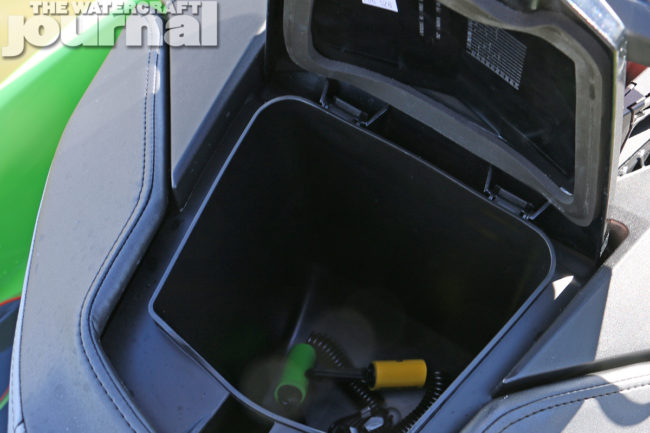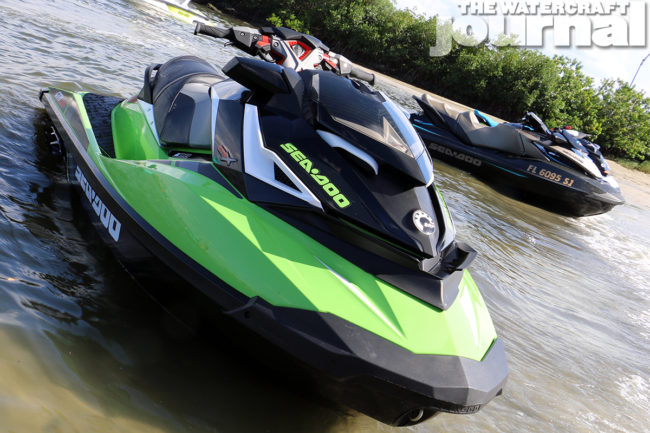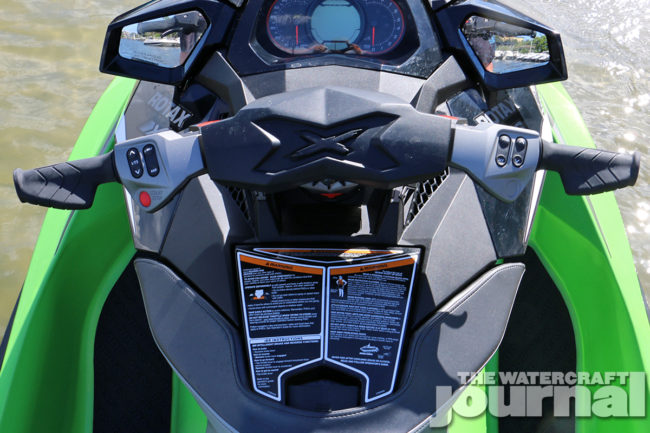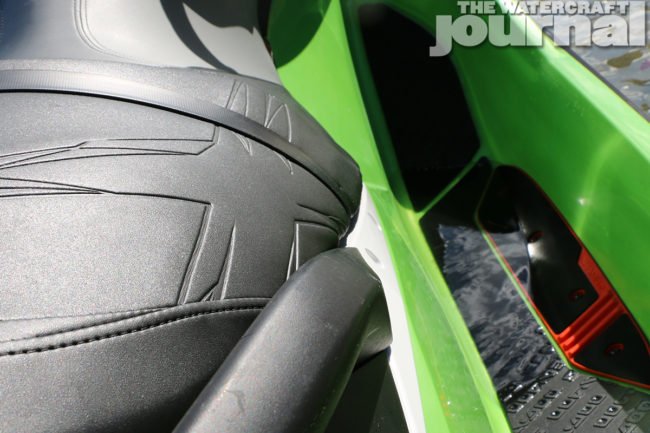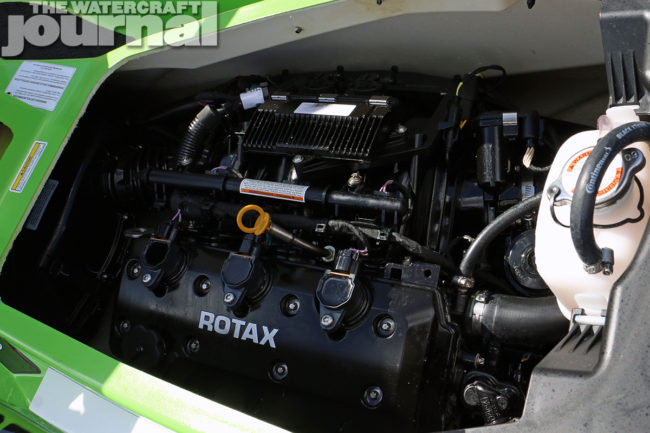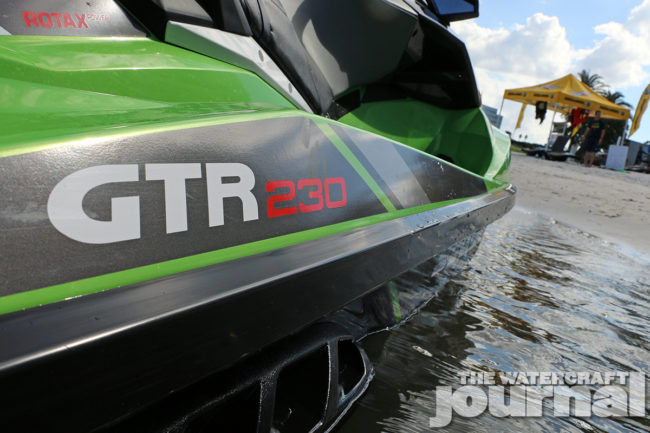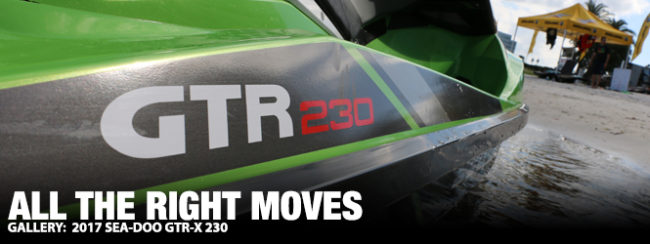
Sometimes the best answers are the simplest ones. We knew Sea-Doo was looking to fill specific “market gaps” in its lineup, but was pleasantly surprised when Sea-Doo revealed the new GTR-X 230 into its 2017 presentation. The integration of the Ergolock seat from the RXP-X to the GTR was easy enough; the two models share the same deck, and its only a matter of a hood, seat, fairings and bracketry to make the exchange possible. The GTR (then powered by a supercharged 215-horsepower 1503 Rotax) was already a popular mid-range performance craft, and while the race-inspired T3 hull of the RXP-X might’ve been a little too aggressive for many, the Ergolock cockpit was too good not to share.
At first blush, we mistook the 2017 Sea-Doo GTR-X 230 as being a well-executed parts bin market segment filler, but were quickly proved wrong, as the machine is truly much more than the sum of its parts. Yes, the GTR-X 230 rides atop the same 130.6-inch long traditional SMC fiberglass hull as the GTI SE 130 and 155, as well as the GTI 155 Limited and GTR 230. The gentle strakes and low-V hull is playful and loose when pressed accordingly, but tracks true and can aptly cruise or sweep a turn when called to action.

Equal all 215, 230 and 260 models, the GTR-X uses the same 159mm pump and the USCG-awarded second generation iBR, which is not only more compact and lighter (weighing approximately 16.4-poounds, including the electronic module and all of the mechanical components) but also allows you to stop nearly 160-feet sooner
Above the bondline would appear to be the same GTI/RXP-X deck, but there too we were wrong. Solely for the 2017 GTR-X 230 is the first use of Sea-Doo’s all-new (and wildly under-promoted) CM-Tech top deck process and material, which we’ve been told will quickly be implemented throughout the lineup in coming years. Unlike traditional SMC, CM-Tech (Closed Mold Technology) is a molding process designed and manufactured exclusively by BRP. The Watercraft Journal spoke with Sea-Doo Watercraft Global Product Manager James Heintz, who explained:

“The main procedural difference is that instead of applying gel coat to the mold before injection, multi-layer thermoformed sheets of Acrylic and ABS are placed into the mold before the fiberglass is injected. This accelerates the process and also improves quality thus reducing the number of rejects. In effect, this creates a high gloss acrylic finish on the top deck that is more resistant to chipping and cracking due to the flexible nature of the acrylic sheets. In addition, the inside of the deck is now smooth, with no protruding sharp pieces of epoxy or fiberglass matting.”
True to his word, the inside of the CM-Tech deck is a smooth, polished surface. While this is a welcomed addition to service technicians everywhere, this is truly a godsend for the performance enthusiast who is all but guaranteed to begin modifying the GTR-X 230 on its second weekend. Gone are evenings picking strands of fiberglass from the tops of your hands and arms. Yet, another aesthetic bonus to CM-Tech is Sea-Doo’s ability to apply rich and layered paint to its watercraft. While not wholly visible in our photography, the GTR-X has an luminescent pearl beneath its California Green Metallic hue that shimmers in the sun.

The biggest outlier distinguishing the GTR-X from the GTR is of course, the use of the Ergolock seat, X-steering system, foot wedges, fairings and hood pilfered from the RXP-X. Encompassing a slightly reduced “X-Package” (there’s no adjustable sponsons on the GTR-X 230 unlike the RXP-X and RXT-X), the GTR-X makes good use of the repositioned rider. Racers have found Ergolock to be greatly beneficial in centering the rider forward and over the handlebars, delivering superior posture, weight placement and response. For the RXP-X 300, its nearly the only thing keeping you attached to the seat. For the GTR-X and its 230-horsepower 1500 HO ACE, it places you in complete control.
As mentioned, the GTI/GTR hull is moderate in its grip. When pushed, the GTR-X 230 clearly communicates how hard you can push in a turn before the tail wants to break free. Toggling the electronic VTS trim nose-down only amplifies this, making rider input all that more important. In fact, use of the VTS presets option has never been more useful. Programming double taps for cornering can have the nose down in one second, and at neutral plane the next. It’s not only a testament to Sea-Doo’s technological prowess, but commitment to producing rider-focused watercraft.

We had immeasurable amounts of fun pushing the GTR-X 230 hard into corners just to see how far we could go. Riding conditions were less than ideal, with temperatures deep into the 90s, even in the morning, with 2-to-3-foot chop, making top speed passes all but impossible. We rattled off a few low 67mph runs, but again, today just wasn’t the day to break any records. Either way, handling is where the fun lies, and we can say with aplomb that the machine delivers. Of course, the lead we’ve been burying is also the GTR-X’s biggest attraction: its all-new 1500 HO ACE powerplant. Replacing the 1503 215-horsepower Rotax 4-tec is a 1,494cc in-line three cylinder.
Although the castings of the crankcase and cylinder case are identical, the 1500 HO benefits from the redesigned cylinder head sporting four valves-per-cylinder, an all-new combustion chamber, improved intake and exhaust porting – all making for superior quench and distribution – as well as the new sleeveless cylinder coatings. The 1500 HO uses a new plasma coating applied via a proprietary thermal spraying process exclusively developed by Rotax’s team in Gunskirchen, Austria, to replace the heavy steel pressed-in sleeves. This not only shaves overall engine weight (totaling 194-pounds), but improves surface durability and heat transference by minimizing friction.

Lastly, the 1500 HO is also equipped with Sea-Doo’s new maintenance-free supercharger and external intercooler. And, thanks to BRP’s iControl engine management, has now been optimized for regular fuel, although we still recommend giving the GTR-X 230 the “good stuff” at the pump. All of this not only makes the GTR-X 230, as Heintz states, “faster and more powerful than its predecessor, but just as fuel efficient.” Fuel capacity remains identical at 15.9 gallons, and storage is on par with the RXP-X rather than the GTR (at 30.7 gallons versus 30.8).
Stepping up from a 2017 GTR 230 to the GTR-X 230 will cost you though, as the X-Package tacks on an additional $1,000, putting the MSRP at $12,999. Of course, the RXP-X is another $2,300 over that, but now you’re comparing apples to oranges. On its own, the 2017 Sea-Doo GTR-X 230 is a wildly enjoyable craft. Its truly the gas-powered, high-speed go-kart your parents kept trying to talk you out of as a kid. It’s fast, fun and squirrelly (when you want it to be). Again, we were surprised at how much we came to enjoy the GTR-X 230 and can not find any other machine comparable to it. It stands out and alone, and that makes it all the more cool to us.









